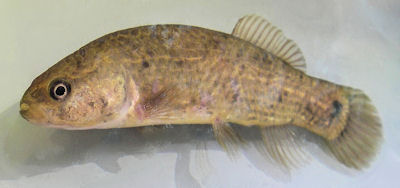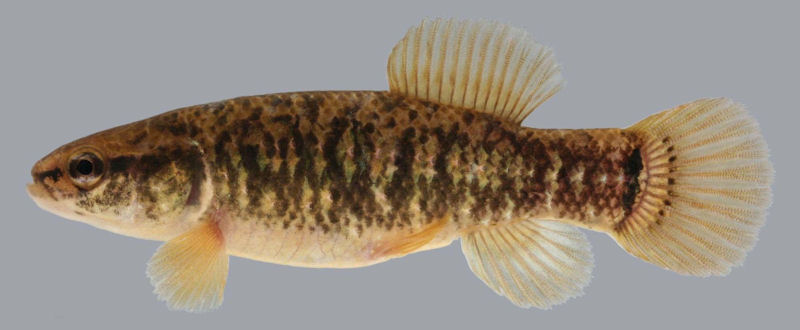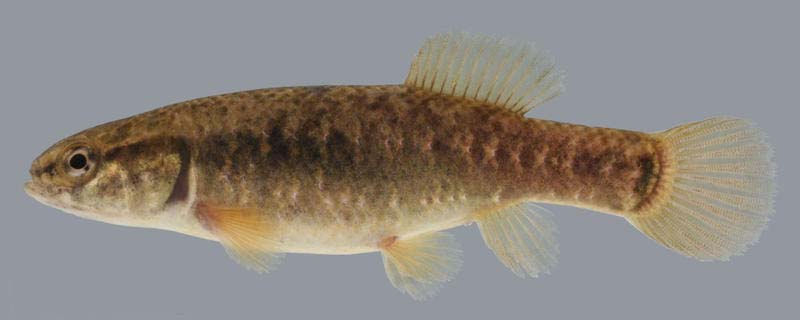Fish in Focus: Mighty Mudminnows, Umbra limi & Umbra pygmaea

Eastern Mudminnow, Umbra pygmaea
Photo by Michael Wolfe
Mighty Mudminnows
(Originally published in American Currents Spring
2012 by Michael Lucas
With all the flashy shiners, brightly colored darters and sunfish, the lowly mudminnow gets little respect. But like many of the commonly overlooked, more somber, every-day natives, when given a chance, mudminnows can generate plenty of respect and interest. Here in New York, year-round brightly colored fish species are relatively sparse compared with many states, so I have been naturally drawn into the world of “ordinary” natives. Specifically mudminnows such as Umbra limi, the Central Mudminnow, found in the Great Lakes area of North America and down the Mississippi as far south as Arkansas and Tennessee with established introductions in Texas, Connecticut, Massachusetts and Maine (USGS). It has been expanding its range eastward in New York through canals (Smith 1985). Bait bucket introductions have also been a means of range expansion (Somerville et al. No Date).
Umbra pygmaea, the Eastern Mudminnow, occurs on the Atlantic coast from southern New York to northern Florida and then west on the Gulf coast to the Aucilla River in Florida and Georgia (Rohde et al. 2009). The Eastern Mudminnow has also been introduced into Europe (Dederen et al. 1986).
These two species are New York’s representatives of the family Umbridae, which worldwide also includes Umbra krameri, the European Mudminnow; Novumbra hubbsi, the Olympic Mudminnow from Washington State; Dallia pectoralis, the Alaska Blackfish from Alaska and tip of Siberia; Dallia admirabilis, the Amguema Blackfish and Dallia delicatissima: these last two are only found in isolated spots in northern Siberia (Nelson 2006).
 male Central Mudminnow, Umbra limi Photo by Uland Thomas |
 female Central Mudminnow, Umbra limi Photo by Uland Thomas |
Both the Central and Eastern Mudminnows are often abundant in small, shallow, vegetated bodies of water or similar areas of larger waters with no or little current. Once while sampling a small weedy ditch-like stream about 3 feet wide and 1.5 feet deep on Grand Island, New York, I was able to catch between 10 and 50 Central Mudminnows with each scoop of a 3 foot seine; numbers which appeared would last as long as I could scoop (Lucas 1988). Mudminnows become most abundant when they can avoid larger predators either by inhabiting the shallower, plant-filled areas or due to habitat conditions such as highly acidic or poorly oxygenated water. Being generally abundant when I’ve found them, mine always seemed to get the leftovers in my fish room. They got the smallest, least decorated, poorly equipped tank or containers. Yet, as long as fed well and given some sort of cover to lurk behind, under or in they would thrive. Over years of collecting and keeping natives the toughness of mudminnows has been repeatedly proven.
Once while collecting in the heat of summer in New Jersey, I found a small marshy pond which apparently had earlier flooded the surrounding area but as it receded, had left behind a large puddle. The drying, tile-cracked mud perimeter indicated the hot weather and direct sun had been shrinking the puddle to its current tepid, putrid sheet of something between liquid and sludge. It was so disgusting that I almost, well at least for a moment, hesitated to dip my aquarium net into it. But being a true fish head I quickly shook off any apprehension and went in full bore repeatedly dredging up several cups of sludge, running to the pond to rinse as much mud as possible which resulted each time in one or more quite fat and healthy-looking Eastern Mudminnows. This amazed me seeing as the water was actually hot to the touch and barely water at all. Plus it was apparent from the tracks captured in the tiles of baked mud that two and four-legged predators had been working the puddle like my family does a Chinese buffet. This illustrates just one benefit of mudminnows being able to breathe atmospheric oxygen.
A study by Virginia Safford Black (1945) has shown that mudminnows are uniquely designed to use oxygen in the water in the presence of relatively high concentrations of CO2 and when that oxygen is mostly used up, switch to the use of oxygen from their swim bladder proving it to be a valuable supplementary organ for respiration.
Not only can mudminnows take the heat but the cold is no match for these super fish. Back in the blizzard of 2007 I shipped a couple of Eastern Mudminnows from Schenectady, New York, to one of Ohio’s veteran fish heads, Skipjack (aka Matt DeLaVega). Shipped Tuesday, they were delayed several days and eventually showed up Saturday, each in a small breather bag and now a block of solid ice. Dropped into an empty tank in his garage to thaw and later be tossed or flushed, they instead slowly thawed out and were later spotted swimming around looking no worse for the ordeal. Not bad for the more southern of the mudminnows.
In a discussion on the NANFA forum, Bruce Stallsmith answered the question of whether this resurrection from being frozen had been previously documented. He reported, “Not in mudminnows, but I've done it with Mummichogs, Fundulus heteroclitus. I put them in a freezer for several hours to euthanize them and they came out solid, but began to move in several minutes as they defrosted. Not such a good euthanasia technique. Natural ‘antifreeze’ substances in animals are almost always proteins with strong hydrophobic properties. I would have to assume that both mudminnows and mummichogs have good complements of them.”
If you do a web search for ‘mudminnows’ the results are often about Mummichogs rather than true mudminnows of the genus Umbra.Another winter, during a pre-spring thaw, cabin fever got the best of my wife and I so we went to hike a nearby trail that ran between a still frozen swamp and a canal. As we walked I noticed the very edge of the ice on the swamp was melted or very thin. If only I had a net! Of course I had a net, carefully packed in my backpack next to the breather bags and thermos of hot chocolate. A couple kicks and the ice opened enough to dip my 10-inch aquarium net into the water and drag it back through the half rotted vegetation, leaves and plant roots. After pulling out shards of ice and debris, much to my surprise, I noticed a few still active water bugs which upon closer inspection turned out to be tiny barely quarter inch baby Central Mudminnows. Apparently spring wasn’t only just in the air but in the mudminnow water as well.
Mudminnows appear to prefer spawning in the earliest spring or even before spring. More evidence of this is found in our own NANFA forum: Mudminnow rough love or playing hard to get (February 19, 2008). In this forum topic Mike Zaborowski, Don Smith, Brian J. Zimmerman, and Ray W. Wolff share experiences with Central Mudminnows being trapped as bait through the ice, held for extended times in a half frozen bait bucket, observed spawning outdoors around the time the ice melts, spawned in the aquarium and even in a pail of collected feeder fish.
The abilities to actively forage during winter and digest meals relatively rapidly at cold temperatures serve as niche-broadening mechanisms and increase the chances of survival. These cold-water foraging adaptations could be an important factor contributing to the development of female gonads over the winter. Winter gonad growth allows for early spring spawning and provides the longest amount of time for the young of year to develop before their first winter (Chilton et al. 1984). In winter, Central Mudminnows can survive hypoxic conditions that kill many other fish (Klinger et al. 1982; Chilton et al. 1984). These fish use an interesting behavior where they ingest air bubbles trapped on the underside of ice-covered lakes (Rahel & Nutzman 1994, Klinger et al. 1983).
As it turns out their unique swim bladder appears to give the mudminnows a fin up on most other fish in withstanding conditions of oxygen deprivation caused by temperature extremes, acidic water, relatively high CO2 ratios and low or other poor water conditions. Their swim bladder is physostomous which means there is a duct connecting the bladder to the pharynx. This allows them to gulp atmospheric air and gas exchange can then occur on the highly vascularized surface of the swim bladder. Other fish, called physoclists, have no open duct so all gas exchange for the purpose of adjusting to changes in hydrostatic pressure must take place between the swim bladder and blood. These fish possess vascular sections of the swim bladder wall which serve for the deposition and absorption of gases. The swim bladder isn’t the only anatomical advantage of the mudminnow. It appears that the Eastern Mudminnow has chloride cells in their branchial epithelium that allow them to not only survive but thrive in very acidic waters (Flik et al. 1987). Acute exposure to water with a pH between 3.5 and 5.0 is lethal for most fish species but both species of mudminnows have been found to be extremely acid-tolerant.
So set up a tank, bucket or container of any size in a spot where temperatures can range from ice water to 90’s with no aeration, water in which few fish could survive, add a few mudminnows and enjoy this unique, hardy fish. Or if you prefer a large well planted aquarium with clean, well-oxygenated water, with a variety of live, frozen and freeze-dried foods, give it a try as these fish might just make it anyway.
Literature Cited
Black, V.S. 1945. Gas Exchange in the Swimbladder of the Mudminnow Umbra limi (Kirtland). Proceedings of the Nova Scotian Institute of Science Vol XXI Part 1 and 2 1942-1944: 65 – 81
Chilton, G., K. Martin, and J. Gee. 1984. Winter feeding: an adaptive strategy broadening the niche of the central mudminnow, Umbra limi. Environmental Biology of Fishes 10: 215-219.
Dederen, L.H.T., R.S.E.W. Leuven, S.E. Wendelaar, and F.G.F. Oyen, 1986. Biology of the acid-tolerant fish species Umbra pygmaea (De Kay, 1842). Journal of Fish Biology, 28: 307–326.
Flik, G., Z. Kolar, J.A. Velden, H.C.M. van der Seegers, C. Zeegers, S.E. Wendelaar Bonga. 1987. Sodium balance in the acid resistant East American Mudminnow, Umbra pygmaea (De Kay). Annales de la Société Royale Zoologique de Belgique. Vol.117: 285-294
Klinger, S., J. Magnuson, G. Gallepp. 1982. Survival mechanisms of the central mudminnow (Umbra limi) and brook stickleback (Culaea inconstans) for low oxygen in water. Environmental Biology of Fishes 7: 113-120.
Lucas M. (1988-1989) Grand Island, Grand Time. American Currents pg. 23
Nelson, J.S. 2006. Fishes of the world. 4th edition. Wiley, Hoboken, New Jersey.
Rahel, F., and J. Nutzman. 1994. Foraging in a lethal environment: fish predation in hypoxic waters of a stratified lake. Ecology 75: 1246-1253.
Rohde, F.C., R.G. Arndt, J.W. Folyz, and J.M. Quattro. 2009. Freshwater fishes of South Carolina. The University of South Carolina Press, Columbia. 430 p.
Smith, C.L. 1985. The inland fishes of New York State. New York State Department of Environmental Conservation, Albany.
Somerville, T.J., S.R. Jamieson, and J.R. Foster. No date. The Invasion of the Central Mudminnow (Umbra limi) Into the Otsego Lake Watershed. http://www.oneonta.edu/academics/biofld/PUBS/ANNUAL/2004/The%20invasion%20of%20the%20central%20mudminnow.pdf. 4p.
U.S. Geological Survey (USGS). http://nas2.er.usgs.gov/viewer/omap.aspx?SpeciesID=977